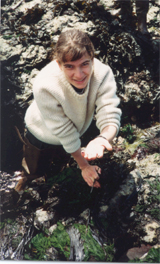 |
|

....Fig 1: Rachel
Collin
Dr Collin describes the work which received the unanimous support of
the adjudicators...
For my dissertation research I used a phylogenetic approach to examine
the evolution of mode of development in calyptraeid gastropods. This
work can be broken down into four major parts:
1. A review of the available data on mode
of development in calyptraeids.
Collin, R. 2003. World-wide patterns of development in calyptraeid gastropods.
Marine Ecology Progress Series 247: 103-122.
This includes a compilation of egg size, hatching size, size at settlement
and presence or absence of nurse eggs. This data was then used to test
the hypotheses that (1) egg-size distribution is bimodal, (2) mode of
development is correlated with latitude, (3) mode of development is
correlated with female body size, (4) hatching size is correlated with
egg size, and (5) time to hatching is correlated with size at hatching.
Analysis of these data shows that egg size is not bimodally distributed
and that mode of development correlates with egg size in species without
nurse eggs. There is a relationship between mode of development and
latitude, but no developmental variables are associated with body size.
There is an unexpected relationship between nurse eggs and latitude:
direct developing species in the southern hemisphere have nurse eggs
while those in the northern hemisphere do not.
2. Phylogenetic analyses of calyptraeids.
Collin, R. 2003. The utility of morphological characters in gastropod
phylogenetics: An example from the Calyptraeidae. Biological Journal
of the Linnean Society 78: 541-593.
Collin, R. Phylogenetic relationships among calyptraeid gastropods and
their implications for the biogeography of speciation. Systematic Biology
(conditionally accepted March 2003).
This includes a phylogenetic analysis of the Calyptraeidae based on
fragments of mitochondrial 16S and cytochrome oxidase c subunit I, and
nuclear 28S genes. 70 species of Crepidula, 11 Crucibulum and 9 Calyptraea
and 5 species in other, lesser calyptraeid genera were included in this
analysis. Monophyletic Calyptraeidae, Crucibulum, and a clade of Crepidula
s.s. cannot be rejected. Calyptraea is clearly polyphyletic as is Crepidula
s.l. The monophyletic genus (or subgenus) Bostrycapulus nests within
a clade comprised of Crucibulum, some Calyptraea and Crepipatella. Western
Pacific Crepidula species and some Calyptraea appear as a poorly resolved
grade at the base of the tree. Shell morphologies are strikingly conservative
in some groups such as Bostrycapulus and Crepipatella where quite divergent
taxa cannot be distinguished on the basis of shell characters. Shell
morphologies are shockingly convergent in some other species and appear
to be associated with substrate specialization. As a result of this
convergence, phylogenetic analyses based on 116 morphological characters
shows little agreement with the topology obtained from the DNA sequence
data.
3. Comparative analysis of the evolution
of development in calyptraeids.
Collin, R. The loss of complex characters, phylogenetic effects, and
the evolution of development in a family of marine gastropods. Evolution
(submitted January 2003).
A comparative analysis of mode of development in the Calyptraeidae was
undertaken to answer the following questions: (1) is the loss of feeding
larvae irreversible? (2) Is there a phylogenetic effect on the evolution
of mode of development? and (3) Do embryos of direct developing species
lose the structures necessary for larval feeding and swimming and if
so is the degree of embryonic modification correlated with the genetic
distance between species? There are three areas of the phylogeny in
which it appears that planktotrophic development may have re-evolved
from species with direct development. In all of these cases they appear
to be derived from species with nurse eggs. There is little support
to the idea that the loss of feeding larvae is irreversible and little
support for phylogenetic effects on these characters. Finally, there
is a correlation between the genetic distance and developmental modification
between sister species. Taken together these results suggest that there
is a window of opportunity after the evolution of direct development
before which the larval characters are lost, during which reversals
to planktotrophic development could occur.
4. Examination of the effects of mode
of development on population structure
Collin, R. 2001. The effects of mode of development
on phylogoegraphy and population structure of North Atlantic Crepidula
(Gastropoda: Calyptraeidae). Molecular Ecology 10: 2249-2262.
I demonstrate that mode of development is associated with levels of
gene flow in Crepidula species from
the east coast of North America. In the direct developing species the
among-population variance accounts for about 80% of the total genetic
variance. Among-population variance accounts for 0-20% of the total
genetic variance in planktotrophic species. In addition, species range
endpoints cluster at well-known biogeographic boundaries and do not
depend on mode of development.
Taken together this work begins to lay a foundation for understanding
the evolution of development at several hierarchical levels. By compiling
a large dataset on the development of species in a large monophyletic
group I have explicitly tested commonly help beliefs about the evolution
of development. These results, combined with a hypothesis of character
evolution within the calyptraeidae, give strong support to the idea
that variation in developmental characters reflects adaptation to current
conditions rather than historical effects. Work that I am currently
conducting at the Smithsonian Tropical Research Institute in Panama
on within-species variation in developmental characters will produce
a full picture of evolution of development in this gastropod family.
I hope that this approach will lead to better understanding of the evolutionary
causes and consequences of mode of development.
Rachel Collin
|
|
